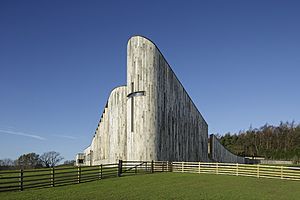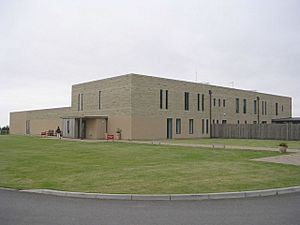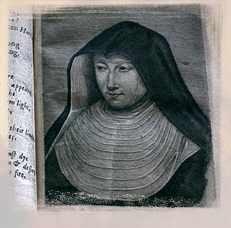Stanbrook Abbey facts for kids
Stanbrook Abbey is a special home for Benedictine nuns. These nuns are part of the Roman Catholic faith. They live a quiet life focused on prayer and reflection. The abbey is now located in Wass, North Yorkshire, England.
The community started a long time ago in 1625 in a place called Cambrai, which is now in France. The nuns had to leave their home during the French Revolution. They moved to England and settled in Stanbrook, Callow End, Worcestershire, in 1838. A new abbey was built there. In 2009, the nuns moved again to Wass in the North York Moors National Park. The old Stanbrook Abbey building in Worcestershire is now a fancy hotel.
Contents
History of Stanbrook Abbey
How it Started
The abbey began in 1623 in Cambrai. It was called "Our Lady of Consolation". It was a place for English Catholic women who had left England. A monk named Dom Benet Jones helped start the project.
Nine young women traveled from England to Cambrai. They moved into an old building and fixed it up. They learned how to be nuns from other experienced nuns. The abbey was officially founded in 1625 when they made their promises to God.
One of the most famous founders was 17-year-old Helen More. She became Dame Gertrude More. She was the great-great-granddaughter of a famous saint, Thomas More. Her father helped pay for the new monastery. Benedictine nuns in England use the special title "Dame."
A wise monk named Dom Augustine Baker taught the young nuns about a special kind of prayer. This way of praying is still used today.
Life in Cambrai
The first leader, called an abbess, was chosen in 1629. Her name was Lady Abbess Catherine Gascoigne. She led the community for 40 years. She was only 28 when she was first chosen, which was younger than usual.
In 1651, the nuns started a new community in Paris. This new group later became Colwich Abbey in England. These two communities came back together in 2020, after 364 years!
The nuns lived in Cambrai for 170 years. They were known for following their rules strictly. They even ran a small school for girls inside their home. The girls followed the same daily routine as the nuns. The nuns also earned money by doing beautiful needlework and embroidery. They also made "fine paperwork," which was cutting paper into amazing designs. They had a large library and translated French spiritual books into English.
People thought highly of their monastery. One report said their church was "extremely small but particularly neat." It also said the nuns were "very observant of their Rule."
The nuns became French citizens in 1678 when France took over Cambrai. Today, a street in Cambrai is still called Rue des Anglaises, meaning "Englishwomen Street."
Arrest and Escape
In 1793, during the French Revolution, the 21 nuns were arrested. They were forced out of their home on October 18. All their property was taken. They were sent to prison in Compiègne for 18 months. Life there was very hard. Four nuns died because of the poor food and sickness.
After asking for permission, the 17 nuns who survived were allowed to leave. They sailed to Dover, England, in May 1795. They arrived with nothing. They even wore clothes left behind by other prisoners.
One nun died in London. Their monastery in Cambrai was destroyed.
Finding a New Home in England
The English Benedictine monks helped the nuns. They sent them to Woolton near Liverpool in May. The nuns were given a house and a girls' school to run. At first, they couldn't wear their special nun's clothes because of anti-Catholic feelings in England.
The nuns lived in two houses and later expanded. They relied on donations at first. The government then gave them a good pension, which helped them financially. Their small school was successful. They taught girls and even a few little boys. One of these boys, John Bede Polding, later became the first Roman Catholic archbishop in Australia.
In 1807, the nuns decided to move again. They realized they couldn't get their old home back in France.
Moving to Abbots Salford
In 1808, the nuns found a temporary home at Salford Hall in Abbot's Salford, Warwickshire. This was a large house built by a Catholic family. It even had a secret priest hole!
The nuns brought their school with them. Here, they could wear their habits again. They also created a special enclosed area in their chapel. But this house was only lent to them. So, in 1835, the nuns bought their own property to build a permanent home.
A monk named Dom Augustine Lawson was their chaplain. He helped them find a new home. When he died in 1830, he asked to be buried with the nuns. When they moved in 1838, his body was moved too. It was found to be perfectly preserved.
The last nun from the original Cambrai group died in 1830. Salford Hall is now a hotel.
Building Stanbrook Abbey in Worcestershire
In 1835, the nuns bought Stanbrook Hall in Callow End, near Malvern, Worcestershire. It was a simple country house. They decided not to live in the hall themselves. They kept it for their priest and his helpers.
For their own home, they hired an architect named Charles Day. He was the brother of one of the nuns. He added a new building next to the hall. This new building had rooms for the nuns, a chapel, and schoolrooms. It was finished in 1838, and the nuns moved in.
The nuns' chapel was special because of its old-fashioned design.
Expanding Stanbrook Abbey
In 1863, a monk named Dom Laurence Shepherd became their chaplain. He helped the nuns become famous for their Gregorian chant (a type of church music). He also encouraged them to build a much bigger, new abbey. The community was growing fast, with many women wanting to become nuns.
The plans for the new abbey were drawn up by Dom Laurence and another monk. The famous Pugin family of architects designed the buildings. Work on the new abbey continued until the end of the 1800s, but it was never fully finished.
The church was the first part to be built, starting in 1869. It was designed in the Gothic Revival style, which looked like old medieval churches. It was finished in 1871.
A special set of old bones, believed to be from a saint named "St Fulgentia," was placed under the main altar.
Covered walkways were built to connect the new church to the older buildings. One walkway had sculptures showing the Stations of the Cross, which tell the story of Jesus's last day.
Work on the main abbey buildings around a central courtyard (called a cloister) began in 1878. The east side, with the main entrance, was finished by 1880. The north side, with the kitchen and dining room, was started in 1895 and finished in 1898.
A special chapel, called the Holy Thorn Chapel, was added in 1885. It was like a medieval shrine. It held a piece of wood believed to be from the crown of thorns of Jesus. Dom Laurence Shepherd was buried here in 1885.
The grand building project stopped around 1900. Some parts, like the west side of the cloister, were never built.
Life and Work at Stanbrook
Stanbrook Abbey became well-known for its Gregorian chant and for publishing religious books. The Stanbrook Abbey Press was one of the oldest private printing presses in England. It was famous for its beautiful printing. While they still do some digital printing, the old-style printing stopped by 1990.
In 1918, the small school at the abbey was closed. This allowed the nuns to follow their strict rules of papal enclosure more fully.
In 1923, a famous furniture maker named Robert "Mouseman" Thompson made tables, chairs, and other furniture for the nuns' dining room. His work is special because it always has a tiny carved mouse on it. These items were moved to the new abbey in Wass.
In 1935, the abbey was very busy with 82 nuns living there. This included nuns who sang in the choir, nuns who did domestic work, and new nuns learning the ropes.
The church was changed in 1937 and again in 1971. Some of the original decorations and altars were removed.
The community was also known for putting English religious texts to music in the plainchant style. The nuns also expanded their guest facilities so more people could stay and experience monastic life.
Moving Again
After 1966, fewer and fewer women wanted to become nuns in the UK. This meant that many monasteries, including Stanbrook Abbey, became too big and expensive to run for the smaller number of nuns. In 2002, there were only 28 nuns left at Stanbrook. They were also getting older.
In April 2002, the nuns announced they would move. The old abbey was very large (79,000 square feet) and expensive to heat.
The nuns looked all over the country for a new home. They bought Crief Farm in Wass. Building the new monastery began in 2007. The nuns moved into their new "Stanbrook Abbey" in Wass on May 21, 2009. The architects were Feilden Clegg Bradley Studios.
Even though they moved, the community decided to keep the name "Stanbrook Abbey" instead of changing it to "Wass Abbey." The first part of the move cost £5 million.
After the move, the old abbey church was officially closed. The special bones of "St Fulgentia" were carefully stored until the new church in Wass was built.
Life at Wass
The old monastery was sold in 2010 for £4.5 million. This money helped pay for the second phase of building in Wass, which was a new church. It was finished in 2015 and cost £2.5 million.
The bones of "St Fulgentia" were placed under the new altar in the new church. The new abbey buildings won an award in 2016.
As of 2020, there were 19 nuns in the community. Stanbrook Abbey is now the second-largest Benedictine nunnery in England.
In 2020, Colwich Abbey also closed. Its remaining nuns moved to Wass, bringing the two communities back together after 364 years.
Stanbrook Abbey Hotel
In August 2010, the old Stanbrook Abbey building in Worcestershire was sold. It was turned into a luxury hotel and event venue called the "Stanbrook Abbey Hotel." The building needed a lot of repairs because the nuns hadn't been able to keep up with maintenance.
The new owners built a grand entrance, car parks, and converted the nuns' old rooms into hotel bedrooms. The grave markers from the nuns' cemetery were moved to a wall, and a lavender garden was planted there. New, modern additions were built, like a large event hall. The hotel opened in 2015.
In 2017, the hotel was sold to a new company. They continued to add more bedrooms and turned the old dining room into a fancy restaurant. By 2020, the hotel had 70 bedrooms.
Leaders of the Abbey
Some of the past leaders (superiors) of Stanbrook Abbey include:
- Dame Gertrude d'Aurillac Dubois (1872-1897) - She oversaw the building of the new abbey in Stanbrook.
- Dame Catherine Gascoigne (1629-1673) - She was the very first Abbess.
- Dame Frances Gawen (1623-1629) - She was the first leader (Prioress) when the community started.
- Dame Scholastica Gregson (1846-1862 and 1868-1872) - She oversaw the building of the church.
- Dame Joanna Jamieson - She was the Abbess who announced the move to Wass.
- Dame Laurentia McLachlan
Other Abbeys Started by Stanbrook
Jamberoo Abbey, Australia
The first Roman Catholic archbishop of Sydney, Australia, John Bede Polding, was taught by the nuns as a little boy. In 1849, he asked Stanbrook Abbey to send nuns to start a new monastery in Australia. Two nuns, Dame Magdalen le Clerc from Stanbrook and Sister Scholastica Gregory from another abbey, started what is now Jamberoo Abbey.
Abadia de Santa Maria, Brazil
In 1907, a group of young women from São Paulo, Brazil, came to Stanbrook to learn how to be nuns. They then went back to Brazil and founded the Abadia de Santa Maria in 1911. This abbey then started three other nunneries in Brazil and one in Argentina. These new abbeys then started even more nunneries in Argentina, Uruguay, and Chile.
Fun Facts
- Stanbrook Abbey was the inspiration for "Brede Abbey" in the 1969 novel In This House of Brede by Rumer Godden.
- The novel The Bell by Iris Murdoch was also partly inspired by Stanbrook Abbey.
- The famous Irish folk singer and harpist Mary O'Hara lived as a nun at Stanbrook Abbey for 12 years.







